Janata Party
This article needs to beupdated.(March 2024) |
Janata Party | |
|---|---|
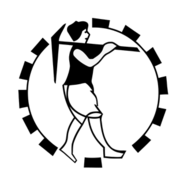 | |
| Abbreviation | JP |
| President | Navneet Chaturvedi |
| Founder | Jayaprakash Narayan |
| Founded | 23 January 1977 |
| Merger of | |
| Succeeded by | |
| Youth wing | Janata Yuva Morcha |
| Women's wing | Janata Mahila Morcha |
| Ideology | Big tent Economic nationalism[1] |
| Political position | Centre-right[2]tocentre-left[3] |
| Colours | Orange, Green |
| Slogan | Janata se Janata ke liye जनता से जनता के लिए |
| ECIStatus | Registered Unrecognised Political Party |
| Election symbol | |
 | |
TheJanata Party(JP,lit. 'People's Party') is an unrecognized political party inIndia.[4]It was founded as an amalgam of Indian political parties opposed tothe Emergencythat was imposed between 1975 and 1977 by Prime MinisterIndira Gandhiof theIndian National Congress.In the1977 general election,the party defeated the Congress and Janata leaderMorarji Desaibecame the first non-Congress prime minister inindependent modern India's history.[5]
Raj Narain,a socialist leader, had filed a legal writ alleging electoral malpractice against Indira Gandhi in 1971. On 12 June 1975,Allahabad High Courtfound her guilty of using corrupt electoral practices in her1971 electionvictory over Narain in theRae Bareli constituency.She was barred from contesting any election for the next six years. Economic problems, corruption and the conviction of Gandhi led to widespread protests against the Congress (R) government, which responded by imposing a State of Emergency. The rationale was that of preserving national security. However, the government introduced press censorship, postponed elections and banned strikes and rallies. Opposition leaders such asJivatram Kripalani,Jayaprakash Narayan,Anantram Jaiswal,Chandra Shekhar,Biju Patnaik,Atal Bihari Vajpayee,L. K. Advani,Raj Narain,Satyendra Narayan Sinha,Ramnandan MishraandMorarji Desaiwere imprisoned,[6]along with thousands of other political activists. When the State of Emergency was lifted and new elections called in 1977, opposition political parties such as theCongress (O),Bharatiya Jana Sangh,Bharatiya Lok Dalas well as defectors from theIndian National Congressjoined to form the Janata party, which won a sweeping majority in theIndian Parliament.Narain defeated Gandhi atRae Bareliin those elections.
The new Janata-led government reversed many Emergency-era decrees and opened official investigations into Emergency-era abuses. Although several major foreign policy and economic reforms were attempted, continuous in-fighting and ideological differences made the Janata government unable to effectively address national problems. By mid-1979,Prime MinisterMorarji Desaiwas forced to resign and his successorChaudhary Charan Singhbecame Prime Minister of India. He remained in office for 23 days untilCongress(I)withdrew support. Popular disenchantment with the political in-fighting and ineffective government led to the resurgence of Gandhi and her newCongress (I)party, which won the general election called in 1980. After Jaiprakash Bandhu now Navneet Chaturvedi is the president of Janata Party since November 2021.[7][8][9][10][11][12]
National units
[edit]
Thakur Ji Pathak(January 1982–20 January 1985) BeforeThakur Ji Pathakwas inJanata party.[13][14]
History
[edit]Having led theIndian independence movement,theIndian National Congressbecame the most popular political party in independent India and won every election following national independence in 1947. However, theIndian National Congressbifurcated in 1969 over the issue of the leadership ofIndira Gandhi,the daughter of India's first prime ministerJawaharlal Nehru.[15]Supporters ofIndira Gandhiclaimed to be the real Congress party, adopting the nameIndian National Congress (R)– where "R" stood for "Requisition." Congress politicians who opposed Indira identified themselves as theIndian National Congress (O)– where "O" stood for "Organisation" or "Old." For the 1971 election, theCongress (O),Samyukta Socialist Partyand theBharatiya Jana Sanghhad formed a coalition called the "Grand Alliance" to oppose Indira Gandhi and theCongress (R),but failed to have an impact;[16]Indira's Congress (R) won a large majority in the 1971 elections and her popularity increased significantly after India's victory in thewar of 1971against Pakistan.[16]
However Indira's subsequent inability to address serious issues such as unemployment, poverty, inflation and shortages eroded her popularity.[16]The frequent invoking of "President's rule"to dismiss state governments led by opposition political parties was seen as authoritarian and opportunist. Political leaders such asJayaprakash Narayan,Acharya KripalaniandCongress (O)chiefMorarji Desaicondemned Indira's government as dictatorial and corrupt. Narayan and Desai founded theJanata Morcha(People's Front), the predecessor of what would become theJanata party.TheJanata Morchawon the elections for theVidhan Sabha(State Legislature) of the state ofGujaraton 11 June 1975.[16][17]
Raj Narain,a leader of theSocialist Party (India),who had unsuccessfully contested election against Indira from the constituency ofRae Bareillyin 1971, lodged a case at theAllahabad High Court,alleging electoral malpractices and the use of government resources for her election campaign. On 12 June 1975 inState of Uttar Pradesh v. Raj Narain,the Allahabad High Court found Indira guilty and barred her from holding public office for six years.[16][17][18]Opposition politicians immediately demanded her resignation and stepped up mass protests against the government. On 25 June, Narayan and Desai held a massive rally inDelhi,calling for a "Satyagraha"– a campaign of non-violentcivil disobedienceto force the government to resign.[16]
Emergency
[edit]On 25 June 1975, thepresident of India,Fakhruddin Ali Ahmed,accepted prime ministerIndira Gandhi's recommendation to declare a state of national emergency.[18][16]Indira argued that the political and civil disorder constituted a threat to national security.[19]A state of emergency enabled the central government to issue executive decrees without requiring the consent ofParliament.[16]Elections were postponed and public gatherings, rallies and strikes were banned. Curfews were imposed and police forces were empowered to make warrantless searches, seizures and arrests. Indira's government imposed "President's rule" in the states ofTamil NaduandGujarat,dismissing the governments controlled by opposition political parties.[16]The central government also imposed censorship on radio, television and newspapers. Across the country, police forces arrested thousands of opposition political activists, as well as leaders such asRaj Narain,Jayaprakash Narayan,Jivatram Kripalani,Anantram Jaiswal,Kamaraj,Morarji Desai,Satyendra Narayan Sinha,Vijaya Raje Scindia,Charan Singh,Atal Bihari Vajpayee,Lal Krishna Advaniand others.[18][16]Opposition political organisations such as the Hindu nationalistRashtriya Swayamsevak Sangh(RSS) and theCommunist Party of India (Marxist)were banned and their leaders arrested.[20]Only theCommunist Party of Indiasupported the state of emergency.[20]Due to the advancing age and failing health, Narayan was released from prison, but remained prohibited from political activity.
During the Emergency, Indira Gandhi implemented a 20-point program of economic reforms that resulted in greater economic growth, aided by the absence of strikes and trade union conflicts. Encouraged by these positive signs and distorted and biased information from her party supporters, Indira called elections for May 1977.[21]However, the emergency era had been widely unpopular. The most controversial issue was the 42nd amendment to theConstitution of India,which deprived citizens of direct access to the Supreme Court, except when violation of the fundamental rights resulted from Union law. The Parliament was given unrestrained power to amend any parts of the Constitution. The Supreme Court was given exclusive jurisdiction as regards determination of the constitutional validity of laws passed by the Union government. It restricted the power of the courts to issue stay orders or injunctions. Almost all parts of the Constitution saw changes through this amendment. The clampdown on civil liberties and allegations of widespread abuse of human rights by police had angered the public. Indira Gandhi was believed, by the public at large to be under the influence of a clique of politicians led by her youngest son,Sanjay Gandhi,who had become notorious for using his influence in the government and the Congress party for alleged corrupt activities.Sanjay Gandhihad masterminded the Union government's unpopular campaign of family planning, which had allegedly involved forcible sterilization of young men by government officials.[16]Sanjay Gandhi had also instigated the demolition of slums in theJama Masjidarea ofNew Delhi,the national capital, which left thousands of people, mostly Muslims, homeless.[16][21]Indian laborers, urban workers, teachers and government employees were also disenchanted by wage freezes and the curtailing of trade union activities and rights.[16][21]
Creation
[edit]Calling elections on 18 January 1977 the government released political prisoners and weakened restrictions and censorship on the press, although the state of emergency was not officially ended. When opposition leaders sought the support ofJayaprakash Narayanfor the forthcoming election, Narayan insisted that all opposition parties form a united front. The Janata Party was officially launched on 23 January 1977 when theJanata Morcha,Charan Singh'sBharatiya Lok Dal,Swatantra Party,theSocialist Party of IndiaofRaj NarainandGeorge Fernandes,and theBharatiya Jana Sangh(BJS) joined, dissolving their separate identities (the merger of all party organisations was to be completed after the election). Although the political ideologies of Janata constituents were diverse and conflicting, the party was able to unite under the over-reaching appeal of Jayaprakash Narayan, who had been seen as the ideological leader of the anti-Emergency movement and now the Janata party.Chandra Shekharbecame first president of Janata Party.Ramakrishna Hegdebecame the party general secretary, and Bharatiya Jana Sangh politicianLal Krishna Advanibecame the party spokesperson.
The Janata manifesto was released on 10 February, which declared that the coming election presented voters with:
a choice between freedom and slavery; between democracy and dictatorship; between abdicating the power of the people and asserting it; between theGandhian pathand the way that has led many nations down the precipice of dictatorship, instability, military adventure and national ruin.[22]
As it became clear that Indira's Emergency rule had been widely unpopular, defections from theCongress (R)government increased. The most significant was that ofJagjivan Ram,who commanded great support amongst India'sDalitcommunities. A former Minister of Defence, Ram left theCongress (R)and along with his supporters formed theCongress for Democracyon 2 February 1977.[23]Other co-founders included the formerChief Minister of OrissaNandini Satpathy,former Union Minister of State for FinanceK. R. Ganesh,formerMPD. N. Tiwari and Bihar politician Raj Mangal Pandey.[23]
Although committing to contest the election with the Janata party, Ram resisted merging his party organisation with Janata. It was ultimately decided that theCongress for Democracywould contest the election with the same manifesto as the Janata party and would join the Janata party in Parliament, but would otherwise retain a separate identity (the CFD would merge with the Janata party after the elections on 5 May).[23]On 30 January 1977 theCommunist Party of India (Marxist)announced that it would seek to avoid a splintering in the opposition vote by not running candidates against the Janata party.
Constituent Parties
[edit]- Bharatiya Lok Dal
- Bharatiya Jana Sangh
- Congress (O)
- Congress for Democracy
- Congress (R)Rebels likeChandra Shekhar,Krishan Kant,Ram Dhan,Mohan Dharia,Chandrajit Yadav,Lakshmi Kanth
1977 elections
[edit]During the election campaign, the leaders of the Congress (R) and the Janata party traveled across the country to rally supporters. Indira and her Congress (R) promoted the record of achieving economic development and orderly government. Although she offered apologies for abuses committed during the Emergency, Indira and the Congress (R) defended the rationale of imposing the state of emergency as being essential for national security. On the other hand, Janata leaders assailed Indira for ruling as a dictator and endangering human rights and democracy in India. Janata's campaign evoked memories of India's freedom struggle againstBritish rule,during whichJayaprakash Narayan,Jivatram KripalaniandMorarji Desaihad first emerged as political leaders. Although Narayan and Kripalani did not seek office themselves, they became the leading campaigners for the Janata party, drawing great masses of people in rallies across the country.[24]
Actions taken during Emergency significantly diminished support for theCongress (R)amongst its most loyal constituencies. The bulldozing of slums near theJama Masjidwas widely unpopular amongst India's Muslims, and the defection ofJagjivan Ramsignificantly diminished support for the Congress (R) amongst India's Dalits.BLDleaderCharan Singh's peasant roots helped him raise considerable support in the rural parts ofUttar Pradesh,the most populous state of India. TheShiromani Akali Dal,the party of theSikhsofPunjaband regional political parties such as theTamil Nadu-basedDravida Munnetra Kazhagambecame important allies. The leaders of theHindu nationalistBharatiya Jana Sanghrallied India's middle-class merchants, traders and conservativeHindus.The Hindu nationalistRSSand trade unions aligned with Janata helped rally considerable voting blocs.
The 1977 election drew a turnout of 60% from an electorate of more than 320 million. On 23 March, it was announced that the Janata party had won a sweeping victory, securing 43.2% of the popular vote and 271 seats. With the support of the Akali Dal and the Congress for Democracy, it had amassed a two-thirds, or absolute majority of 345 seats. Although the Congress for Democracy won 28 seats, Ram's standing as a national Dalit leader and moving a significant share of the Dalit vote to the Janata party and its allies won him considerable influence.[23]
In contrast to the rest of the country, the Janata party won only six seats from India's southern states – none from the state ofKerala– where the Emergency had not caused political unrest. TheCongress (R)won a total of 153 seats, mainly from India's south. However, Janata candidates resoundingly defeated Congress (R) candidates in the northern "Hindi belt",especially inUttar Pradesh.One of the most shocking outcomes of the election was the defeat of Indira Gandhi in her bid to seek re-election from her constituency ofRae Bareilly,which she lost to her 1971 opponentRaj Narainby a margin of 55,200 votes. The Congress (R) did not win any seats in Uttar Pradesh and was wiped out in 10 states and territories by Janata candidates.
Summary of the 1977 MarchLok Sabhaelection resultsof India, using alliances under Morarji Government from 1977 to 1979
Sources: Keesing's – World News Archive
| Alliances | Party | Seats won | Change | Popular votes % |
|---|---|---|---|---|
| Janata alliance Seats:345 Seat Change:+233 Popular vote %:51.89 |
Janata Party /Congress for Democracy | 298 | +245 | 43.17 |
Government formation
[edit]On the morning of 24 March,Jayaprakash NarayanandJivatram Kripalaniled the newly elected Janata MPs toRaj Ghat,where the ashes ofMahatma Gandhiwere laid, and administered a pledge to continue Gandhi's work and preserve honesty in serving the nation.[25]Immediately afterwards, the Janata party faced a serious challenge in choosing a leader to become India's new prime minister, where the rival bids of party leaders could divide the party and weaken its majority before it took power. Janata party chairmanMorarji Desai,Charan SinghandJagjivan Ramenjoyed the support of a significant number of Janata MPs and the activists brought from their own political parties into the Janata organisation.[25]To avoid a potentially divisive contest, Janata leaders askedJayaprakash NarayanandJivatram Kripalanito select the party's leader, pledging to abide by their choice.[25]After a period of deliberation, Narayan and Kripalani selectedMorarji Desaito become the chairman of the Janata Parliamentary Party on 24 May. Although some leaders such asGeorge FernandesandJagjivan Ramhesitated to support Desai and criticized the undemocratic method of selection, Desai's position was soon confirmed and consolidated.[25]
Taking office as prime minister, Desai also took charge of the Ministry of Finance. He sought to carefully distribute important posts to satisfy Janata's different constituents and the most powerful party leaders who were rivals for his own position of leadership. BothCharan SinghandJagjivan Ramwere accorded the title of deputy prime minister.Charan Singhbecame the Minister of Home Affairs, the second-most important position in the Council of Ministers, whileJagjivan Ramtook charge of the Ministry of Defence.BJSleadersAtal Bihari VajpayeeandLal Krishna Advaniwere respectively given charge of theMinistry of External Affairsand theMinistry of Information and Broadcasting.Raj Narainwas appointedMinister of Health,Madhu Dandavatewas to head theMinistry of Railwaysand trade unionistGeorge Fernandeswas made theMinistry of Communications.JuristShanti Bhushanwas appointedMinister of Law and Justice.[26]Congress (O)veteran and Janata candidateNeelam Sanjiva Reddywon thepresidential electionto become the 6th President of India on 25 July 1977.
The results of its election defeat considerably weakened and diminished theCongress (R).Significant numbers ofCongress (R)MPs and activists condemned Indira's leadership and left the party. As a result, MPs still loyal to Indira Gandhi renamed their party toCongress (I)– "I" standing for Indira. Although no longer an MP, Indira Gandhi continued as the president ofCongress (I),which remained the largest opposition party.
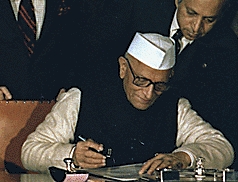
Janata rule
[edit]The first actions taken by the Desai government were to formally end the state of emergency and media censorship and repeal the controversial executive decrees issued during the Emergency.[21][25]The Constitution was amended to make it more difficult for any future government to declare a state of emergency; fundamental freedoms and the independence of India's judiciary was reaffirmed.[21][25]
The new government also proceeded to withdraw all charges against the 25 accused in theBaroda dynamite case,which included the new Minister of Industry,George Fernandes.[25]The Minister of Railways reinstated the railway employees disciplined after the May 1974 strike.[25]The Desai government proceeded to establish inquiry commissions and tribunals to investigate allegations of corruption and Indira Gandhi's government, political party and the police forces. Specific inquiries were instituted onSanjay Gandhi's management of the state-ownedMaruti Udyog Ltd.,the activities of the former Minister of DefenceBansi Laland the1971 Nagarwala scandal.[25]Both Indira and her son Sanjay were charged with allegations of corruption and briefly arrested.
Elections in the states
[edit]Immediately upon taking office, the Janata government pressured the ten state governments where the Congress was in power to dissolve the state assemblies and hold fresh elections in June.Tamil Naduwitnessed the massive victory of theAIADMK,led byM. G. Ramachandran.Home Minister Charan Singh argued that the ruling party had been resoundingly rejected by voters and would need to win a new mandate from the people of the states. The Congress (R) was defeated in all the states, and the Janata party took power in seven – Uttar Pradesh, Bihar, Haryana, Orissa, Madhya Pradesh, Rajasthan and Himachal Pradesh. In Punjab, the Janata party formed a coalition government with the Akali Dal. In Bihar,Karpuri Thakurwon the closely contested Janata legislature party leadership from the[27]then Bihar Janata Party chiefSatyendra Narayan Sinhato become the BiharChief Minister.The number of Janata members of the legislative assemblies (MLAs) of all the states increased from 386 to 1,246 seats. The government also called fresh elections in the state ofJammu and Kashmir,where the Janata party won 13 seats to the Congress's 11, and the veteran Kashmiri politicianSheikh Abdullahreturned to power after having been dismissed in 1953.
Foreign policy
[edit]Prime Minister Morarji Desai and the Minister of External AffairsAtal Bihari Vajpayeebegan significant changes in India's foreign policy, moving away from the course adopted by Indira's government. Both Pakistan and China had celebrated the ouster of Indira Gandhi, who had preserved a hardline stance against India's rival neighbors. In 1979,Atal Bihari Vajpayeebecame the highest-ranking Indian official to visit Beijing, meeting China's leaders. The Desai government re-established diplomatic relations with the People's Republic of China, which had been severed due to theSino-Indian War of 1962.Both nations established regular dialogue to resolve long-standing territorial disputes, expand trade and enhance border security. The Desai government ended India's support for the guerrillas loyal toSheikh Mujibur Rahman,the founding leader of Bangladesh, who had been assassinated in 1975 by military officers and replaced by a military regime that sought to distance itself from India.
India also sought to improve relations with the United States, which had been strained due to the latter's support for Pakistan during the 1971 war and India's subsequent proximity with theSoviet Union.The Janata government announced its desire to achieve "genuine"non-alignmentin theCold War,which had been the long-standing national policy. In 1978,Jimmy Carterbecame the third U.S. president to make an official visit to India. Both nations sought to improve trade and expand cooperation in science and technology. Vajpayee represented India at the U.N. conference on nuclear disarmament, defending India's nuclear programme and its refusal to sign non-proliferation treaties.
Economic policy
[edit]The Janata government had lesser success in achieving economic reforms. It launched the Sixth Five-Year Plan, aiming to boost agricultural production and rural industries. Seeking to promote economic self-reliance and indigenous industries, the government required multi-national corporations to go into partnership with Indian corporations. The policy proved controversial, diminishing foreign investment and led to the high-profile exit of corporations such asCoca-ColaandIBMfrom India.[28]
List of Chief Ministers
[edit]| No | Portrait | Name | Constituency | State | Term of office | Tenure length | Assembly | |
|---|---|---|---|---|---|---|---|---|
| 1 | Prem Khandu Thungan | Dirang Kalaktang | Arunachal Pradesh | 13 August 1975 | 18 September 1979 | 4 years, 36 days | 1st (1978 Arunachal Pradesh election) | |
| 2 | Babubhai Patel | Sabarmati | Gujarat | 11 April 1977 | 17 February 1980 | 2 years, 312 days | 5th (1975 Gujarat election) | |
| 3 | 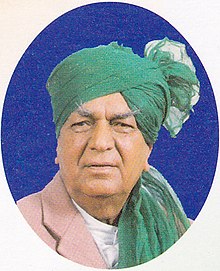 |
Devi Lal | Bhattu Kalan | Haryana | 21 June 1977 | 28 June 1979 | 2 years, 7 days | 5th (1977 Haryana elections) |
| 4 |  |
Shanta Kumar | Sullah | Himachal Pradesh | 22 June 1977 | 14 February 1980 | 2 years, 237 days | 4th (1977 Himachal Pradesh election) |
| 5 |  |
Bhairon Singh Shekhawat | Chhabra | Rajasthan | 22 June 1977 | 16 February 1980 | 2 years, 239 days | 6th (1977 Rajasthan election) |
| 6 | 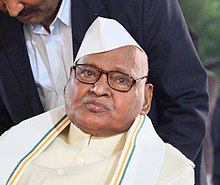 |
Ram Naresh Yadav | Nidhauli Kalan | Uttar Pradesh | 23 June 1977 | 28 February 1979 | 1 year, 250 days | 7th (1977 Uttar Pradesh election) |
| 7 |  |
Karpoori Thakur | Phulparas | Bihar | 24 June 1977 | 21 April 1979 | 1 year, 301 days | 7th (1977 Bihar election) |
| 8 | 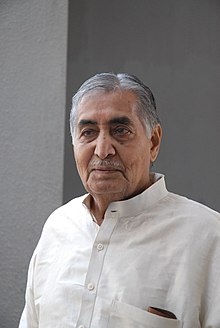 |
Kailash Chandra Joshi | Bagli | Madhya Pradesh | 24 June 1977 | 18 January 1978 | 208 days | 6th (1977 Madhya Pradesh election) |
| 9 |  |
Nilamani Routray | Basudevpur | Odisha | 26 June 1977 | 17 February 1980 | 2 years, 236 days | 7th (1977 Odisha election) |
| 10 | Yangmaso Shaiza | Ukhrul | Manipur | 29 June 1977 | 13 November 1979 | 2 years, 137 days | 3rd (1974 Manipur election) | |
| 11 | Radhika Ranjan Gupta | Fatikroy | Tripura | 26 July 1977 | 4 November 1977 | 101 days | 3rd (1972 election) | |
| 12 | Virendra Kumar Sakhlecha | Jawad | Madhya Pradesh | 18 January 1978 | 20 January 1980 | 2 years, 2 days | 6th (1977 Madhya Pradesh election) | |
| 13 |  |
Golap Borbora | Tinsukia | Assam | 12 March 1978 | 4 September 1979 | 1 year, 176 days | 6th |
| 14 |  |
Banarasi Das | Hapur | Uttar Pradesh | 28 February 1979 | 17 February 1980 | 354 days | 7th (1977 Uttar Pradesh election) |
| 15 |  |
Ram Sundar Das | Sonepur | Bihar | 21 April 1979 | 17 February 1980 | 302 days | 7th (1977 Bihar election) |
| 16 |  |
Bhajan Lal | Adampur | Haryana | 28 June 1979 | 23 May 1982 | 2 years, 329 days | 5th (1977 Haryana elections) |
| 17 | 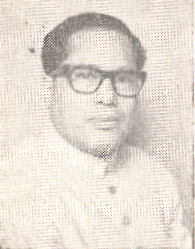 |
Jogendra Nath Hazarika | Duliajan | Assam | 9 September 1979 | 11 December 1979 | 93 days | 6th |
| 18 | Sunderlal Patwa | Mandsaur | Madhya Pradesh | 20 January 1980 | 17 February 1980 | 28 days | 6th (1977 Madhya Pradesh election) | |
| 19 | Ramakrishna Hegde | Kanakpura | Karnataka | 10 January 1983 | 7 March 1985 | 5 years, 216 days | 7th (1983 Karnataka election) | |
| (19) | Ramakrishna Hegde | Basavanagudi | Karnataka | 8 March 1985 | 13 August 1988 | 3 years, 158 days | 8th (1985 Karnataka election) | |
| 20 | 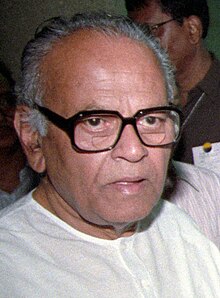 |
S. R. Bommai | Hubli Rural | Karnataka | 13 August 1988 | 21 April 1989 | 281 days | 8th (1985 Karnataka election) |
Fall of the government
[edit]Despite a strong start, the Janata government began to wither as significant ideological and political divisions emerged.[16]The party consisted of veteran socialists, trade unionists and pro-business leaders, making major economic reforms difficult to achieve without triggering a public divide.[16]Socialists and secular Janata politicians shared an aversion to the Hindu nationalist agenda of theRashtriya Swayamsevak Sangh,whose members included Vajpayee, Advani and other leaders from the formerBharatiya Jana Sangh.Violence between Hindus and Muslims led to further confrontations within the Janata party, with most Janata leaders demanding thatAtal Bihari VajpayeeandLal Krishna Advanichoose between staying in government and being members of theRSS.Both Vajpayee and Advani as well as other members of the former BJS opted to remain members of the RSS and consequently resigned from their posts and from the party.
The decline in the popularity of the Janata government was aided by the stalled prosecution of Emergency-era abuses. The government had failed to prove most of the allegations and obtained few convictions. Cases against Indira Gandhi had also stalled for lack of evidence, and her continued prosecution began to evoke sympathy for her from the Indian public and anger of her supporters, who saw it as a "witch hunt."[18]
In June 1978,Raj Narainattacked party presidentChandra ShekharandBharatiya Jana Sangh.On 16 June 1978,Charan Singhannounced his resignation from Janata Party parliamentary board. Janata Party parliamentary board which met on 22 June 1978 issued show-cause notices toRaj Narain,Devi Lal,Ram Dhan,Jabbar Singh and Sibhan Lal Saxena.[29]On 1 July 1978,Charan Singhresigned from the cabinet ofMorarji Desaibecause of growing differences between them over trial ofIndira Gandhi.[30][31]On 24 January 1979,Charan Singhreturned into cabinet and held portfolios ofMinister of Financeand becomingDeputy Prime Minister.[32][30]Hirubhai M. Patelwas shifted fromFinance ministrytoHome Ministry.[33]
Through 1979, support forMorarji Desaihad declined considerably due to worsening economic conditions as well as the emergence of allegations of nepotism and corruption involving members of his family. Desai's confrontational attitude eroded his support.[18]His main rivalCharan Singhhad developed an acrimonious relationship with Desai.[26]Protesting Desai's leadership, Singh resigned and withdrew the support of hisBharatiya Lok Dal.Desai also lost the support of the secular and socialist politicians in the party, who saw him as favoring the Hindu nationalistBharatiya Jana Sangh.[16]On 19 July 1979 Desai resigned from the government and eventually retired to his home inMumbai(then Bombay).[18]The failing health ofJayaprakash Narayanmade it hard for him to remain politically active and act as a unifying influence, and his death in 1979 deprived the party of its most popular leader. Dissidents projectedCharan Singhas the new prime minister in place of Desai.
PresidentNeelam Sanjiva ReddyappointedCharan Singhas the Prime Minister of a minority government on the strength of 64 MPs, calling upon him to form a new government and prove his majority. The departure of Desai and the BJS had considerably diminished Janata's majority, and numerous Janata MPs refused to support Charan Singh. MPs loyal toJagjivan Ramwithdrew themselves from the Janata party. Former allies such as the DMK, Shiromani Akali Dal and the Communist Party of India (Marxist) had distanced themselves from the Janata party. Desperately seeking enough support for a majority, Charan Singh even sought to negotiate with Congress (I), which refused. After only three weeks in office, Charan Singh resigned. With no other political party in position to establish a majority government, President Reddy dissolved the Parliament and called fresh elections for January 1980.[16]
In1980 general elections,Janata Party declaredJagjivan Ramas its Prime Ministerial candidate, but the party won only 31 seats out of 542.[34]
Party Presidents
[edit]- Chandra Shekhar(1977–1988)[35]
- Ajit Singh(1988–1990)[36]
- Subramanian Swamy(1990–2013)[37]
- Jai Prakash Bandhu (2013- 2021)
- Navneet Chaturvedi (2021–Present)[7][38][11][39]
General election results
[edit]Lok Sabha seats
[edit]| Year | Legislature | Seats contested | Seats won | Change in seats | Percentage of votes | Vote swing | Ref. |
|---|---|---|---|---|---|---|---|
| 1977 | 6th Lok Sabha | 405 | 295 / 542
|
41.32% | [40] | ||
| 1980 | 7th Lok Sabha | 433 | 31 / 529
|
18.97% | [41] | ||
| 1984 | 8th Lok Sabha | 207 | 10 / 514
|
6.89% | [42] | ||
| 1989 | 9th Lok Sabha | 155 | 0 / 529
|
1.01% | [43] | ||
| 1991 | 10th Lok Sabha | 349 | 5 / 521
|
3.37% | [44] | ||
| 1996 | 11th Lok Sabha | 101 | 0 / 543
|
0.19% | [45] | ||
| 1998 | 12th Lok Sabha | 16 | 1 / 543
|
0.12% | [46] | ||
| 1999 | 13th Lok Sabha | 26 | 0 / 543
|
0.05% | [47] |
State units
[edit]Karnataka
[edit]Presidents
[edit]Veerendra Patil(1977–78)[48]
H. D. Deve Gowda(1978)[48]
D. Manjunath(1983)[49]
M. P. Prakash(1987)[50]
Secretary General
[edit]Jeevaraj Alva(1988–1990)[51]
Uttar Pradesh
[edit]Tamil Nadu
[edit]President
[edit]Status
[edit]In the run-up to the 1980 elections, the remaining Janata party leaders tried unsuccessfully to rebuild the party and make fresh alliances. Desai campaigned for the party but did not himself stand for election, preferring retirement from politics. The Congress (I) capitalized on the aversion of the Indian public to another fragile and dysfunctional government by campaigning on the slogan "Elect A Government That Works!"[16]Indira Gandhi apologized for mistakes made during the Emergency and won the endorsement of respected national leaders such asVinoba Bhave.At the polls, the candidates running under the Janata ticket were resoundingly defeated – the party lost 172 seats, winning only 31. Indira Gandhi and the Congress (I) returned to power with a strong majority. Sanjay Gandhi was also elected to the Parliament. President Reddy was succeeded at the end of his term in 1982 by Congress (I) leaderZail Singh.(RUPPS).
Between 1980 and 1989, the Janata party maintained a small presence in the Indian Parliament under the leadership of socialist politicianChandra Sekhar.[52]In 1988, Lok Dal (A) was merged into Janata Party andAjit Singhwas made its president.[53]After some months, it merged into theJanata Dal,which had emerged as the chief opposition party under the leadership ofVishwanath Pratap Singhand the main constituent of theNational Frontcoalition.[52]Singh had become widely popular for exposing the role of the government of prime ministerRajiv Gandhi,the eldest son and successor of Indira, in theBofors scandal,though on 5 February 2004, theDelhi High Courtquashed the charges of bribery against Rajiv Gandhi and others.[52][54]
But some leaders of Janata Party refused to accept its merger into Janata Dal and continued in Janata Party.[55][56]These included Indubhai Patel,Subramanian Swamy,Syed Shahabuddin,H. D. Deve Gowda,Sarojini Mahishi.[55][57]On 4 January 1989, Indubhai Patel was declared as acting president of Janata Party.[58]Janata Dal filed an application toElection Commission of Indiato seek the transfer of Janata Party symbol to its own.[59]But the Election Commission froze the symbolchakra–haldharfor1989 general electionand as a result, Janata Dal had to usewheelas their election symbol.[60]Janata Party continue to retain its status asunrecognised registered partywith Election Commission of India and retains its symbol ofchakra-haldhar.[61]
Since the original Janata Party disappeared when it merged into the Janata Dal, these two(the 1977 one and present one) are considered as distinct from one another by many.[62]
Under V. P. Singh, the Janata Dal and the National Front sought to replicate the Janata-style alliance of anti-Congress political parties.[52]Although it failed to win a majority, it managed to form a fragile coalition government with V.P. Singh as the prime minister with the outside support of the BJP and the Communist Party of India (Marxist).[52]However, Singh's government soon fell victim to intra-party rivalries and power struggles, and his successor Chandra Sekhar's Janata Dal (Socialist) government lasted barely into 1991.[52]
Legacy
[edit]Although its tenure in office was tumultuous and unsuccessful, the Janata party played a definitive role in Indian politics and history and its legacy remains strong in contemporary India. The Janata party led a popular movement to restore civil liberties, evoking the memories and principles of the Indian independence movement. Its success in ending 30 years of uninterrupted Congress rule helped strengthen India's multi-party democracy. The term "Janata" has been used by several major political parties such as theBiju Janata Dal(BJD),Bharatiya Janata Party(BJP),Janata Dal (United),Janata Dal (Secular),Rashtriya Janata Daland others.
Participants in the struggle against theIndian Emergency (1975–77)and of the Janata party went on to comprise a new generation of Indian political leaders.Chandra Shekhar,Atal Bihari VajpayeeandDeve Gowdawent on to serve as Prime Ministers; Vajpayee led the first non-Congress government to complete a full five-year term from 1999 to 2004.Lal Krishna Advaniserved as deputy prime minister. Younger politicians such asSubramanian Swamy,Arun Jaitley,Pramod Mahajan,Sushma Swarajand others were grass-roots activists in the Janata party.
The Janata Party continued to exist led bySubramanian Swamy,which maintained a small presence in the politics of the state ofTamil Nadu,Karnataka,Andhra Pradesh,Kerala,Maharashtra,Chandigarh,Delhi and at the national stage. Janata party continued its lead as opposition in AP until the formation of TDP party, due to prominent leaders such asJaipal Reddy,Babul Reddy and T. Gajula Narasaiah.
See also
[edit]Further reading
[edit]- Shourie, Arun (1980). Institutions in the Janata phase. Bombay: Popular.
References
[edit]- ^Shashi Tharoor(2006).India: From Midnight To Millennium.Arcade Publishing. pp. 164–66.ISBN978-1-55970-803-6.
- ^"Why the Far Right Rules Modi's India".Jacobin.Retrieved4 June2024.
In this vacuum, the BJP's path to power followed that of three other centrist parties, similar to Congress, which led coalitions on three separate occasions.
- ^Gould, Harold(20 May 2019).India Votes Alliance Politics And Minority Governments In The Ninth And Tenth General Elections.Taylor and Francis.ISBN9780429722776.Retrieved19 June2024.
- ^"List of Political Parties and Free Symbols"(PDF).Election Commission of India.10 March 2014.
- ^Dr. Pavithran K.S. (2020).The Janata Interludes.VIJ Books (India) PVT Limited.ISBN9789389620184.Retrieved19 July2024.
- ^Official Excerpts from Speech of Veteran Journalist.Emergency: Top Oppositional political leaders arrested.Website.Archivedfrom the original on 23 September 2015.Retrieved31 August2015.
- ^ab"जिओ पॉलिटिक्स के लेखक नवनीत चतुर्वेदी जनता पार्टी के राष्ट्रीय अध्यक्ष बने | Journo Mirror".18 December 2021.Archivedfrom the original on 25 January 2024.Retrieved25 January2024.
- ^"चुनाव स्थगित करने हेतु जनता पार्टी राष्ट्रीय अध्यक्ष नवनीत चतुर्वेदी द्वारा सुप्रीम कोर्ट में जनहित याचिका - अग्नि आलोक".14 January 2022.Archivedfrom the original on 25 January 2024.Retrieved25 January2024.
- ^Malviya, Pavan (12 November 2023)."विधानसभा चुनाव राजस्थान और मध्यप्रदेश जहां जनता पार्टी गेम चेंजर की भूमिका मे खड़ी हो चुकी है - नवनीत चतुर्वेदी".दैनिक भास्कर हिन्दी (Dainik Bhaskar Hindi)(in Hindi).Archivedfrom the original on 25 January 2024.Retrieved25 January2024.
- ^"Political News: जनता पार्टी ने ठुकराया संयुक्त विपक्ष का प्रस्ताव, नए चेहरों को मौका देकर करेगी मिशन 2024 की तैयारी | Janta party President navneet chaturvedi distanced himself from all-party meeting, rejected proposal joint opposition".Patrika News(in Hindi). 22 June 2023.Archivedfrom the original on 17 January 2024.Retrieved25 January2024.
- ^"ब्राह्मण समाज के समर्थन में आई जनता पार्टी: नवनीत चतुर्वेदी".www.navodayatimes.in.3 June 2023.Archivedfrom the original on 28 March 2024.Retrieved25 January2024.
- ^"Janata party leader Thakur ji Pathak".21 March 2022.Archivedfrom the original on 9 January 2023.Retrieved9 January2023.
- ^Mitra, H. N. (1994).The Indian Annual Register A Digest Of Public Affairs Of India..., Volumes 1-2.Gyan Publishing House. p. 228.ISBN978-81-212-0213-8.Archivedfrom the original on 28 March 2024.Retrieved11 January2023.
Janata Dal leader of Singhbhum, Thakurji Pathak...
- ^"The Congress".Library of CongressCountry Studies.Archivedfrom the original on 28 March 2024.Retrieved5 July2009.
- ^abcdefghijklmnopqr"The Rise of Indira Gandhi".Library of CongressCountry Studies.Archivedfrom the original on 2 August 2017.Retrieved27 June2009.
- ^abKatherine Frank (2002).Indira: The Life Of Indira Nehru Gandhi.Houghton Mifflin Harcourt. pp.371.ISBN978-0-395-73097-3.
- ^abcdefKuldip Singh (11 April 1995)."Obituary: Morarji Desai".The Independent.London.Archivedfrom the original on 3 November 2012.Retrieved27 June2009.
- ^Katherine Frank (2002).Indira: The Life Of Indira Nehru Gandhi.Houghton Mifflin Harcourt. pp.377.ISBN978-0-395-73097-3.
- ^abKatherine Frank (2002).Indira: The Life Of Indira Nehru Gandhi.Houghton Mifflin Harcourt. pp.382.ISBN978-0-395-73097-3.
- ^abcdePaul R. Brass (1994).The Politics of India Since Independence.Cambridge University Press.pp. 40–50.ISBN978-0-521-45970-9.
- ^G. G. Mirchandani (2003).320 Million Judges.Abhinav Publications. pp. 98–126.ISBN81-7017-061-3.
- ^abcdG. G. Mirchandani (2003).320 Million Judges.Abhinav Publications. pp. 90–100.ISBN81-7017-061-3.
- ^Janak Raj Jai; Rajiv Jai (1999).Political Trends Revival of Two Party System in India: Ruling Vs. Combined Opposition.Regency Publications.ISBN9788186030165.Retrieved19 July2024.
...Jaya Prakash Narayan then gave a call for total revolution, and as such all opposition political parties responded to the call of JP and fought elections under his leadership.
- ^abcdefghiG. G. Mirchandani (2003).320 Million Judges.Abhinav Publications. pp. 176–191.ISBN81-7017-061-3.
- ^ab"Morarji, Charan Singh waited for each other to die: Book".The Indian Express.11 November 2008. Archived fromthe originalon 15 December 2008.Retrieved27 June2009.
- ^Mirchandani, G. G. (June 2003).Bihar chief ministership battle 1977.Abhinav Publications.ISBN978-81-7017-061-7.Archivedfrom the original on 23 January 2024.Retrieved4 June2007.
- ^Shashi Tharoor (2006).India: From Midnight To Millennium and Beyond.Arcade Publishing. pp. 164–66.ISBN978-1-55970-803-6.
- ^Ananth, V. Krishna (2010).India Since Independence: Making Sense of Indian Politics.Pearson India. p. 220.ISBN978-81-317-3465-0.Archivedfrom the original on 28 March 2024.Retrieved11 March2023.
- ^ab"Chaudhary Charan Singh: Stalwart farmer leader who was PM for 170 days".The Indian Express.22 May 2022.Archivedfrom the original on 16 February 2023.Retrieved10 March2023.
- ^Brass, Paul R. (2014).An Indian Political Life: Charan Singh and Congress Politics, 1967 to 1987 - Vol.3 (The Politics of Northern India).Sage India. p. 243.ISBN978-93-5150-032-2.
- ^"HT This Day: Jan 24, 1979 - Charan Singh, J. Ram become Dy PMs today".Hindustan Times.23 January 2022.Archivedfrom the original on 10 March 2023.Retrieved3 March2023.
- ^Ananth, V. Krishna (2010).India Since Independence: Making Sense of Indian Politics.Pearson India. p. 227.ISBN978-81-317-3465-0.Archivedfrom the original on 28 March 2024.Retrieved11 March2023.
- ^"General Election, 1980 (Vol I, II)".Election Commission of India.Archivedfrom the original on 21 September 2021.Retrieved25 December2021.
- ^"Shri Chandra Shekhar | Prime Minister of India".www.pmindia.gov.in.Archivedfrom the original on 17 June 2019.Retrieved29 January2022.
- ^Prabhu Chawla (15 June 1988)."Ajit Singh catapulted as Janata Party president".India Today.Archivedfrom the original on 29 January 2022.Retrieved29 January2022.
- ^"Subramanian Swamy".Business Standard India.Retrieved29 January2022.
- ^"Political News: जनता पार्टी ने ठुकराया संयुक्त विपक्ष का प्रस्ताव, नए चेहरों को मौका देकर करेगी मिशन 2024 की तैयारी | Janta party President navneet chaturvedi distanced himself from all-party meeting, rejected proposal joint opposition".Patrika News(in Hindi). 22 June 2023.Archivedfrom the original on 17 January 2024.Retrieved25 January2024.
- ^"राजनीतिक रण में एतिहासिक जनता पार्टी एक बार फिर से नए युवा चेहरे व ब्राह्मण नेतृत्व के साथ उतरने को तैयार - mobile".punjabkesari.7 June 2023.Archivedfrom the original on 28 March 2024.Retrieved25 January2024.
- ^"General Election, 1977 (Vol I, II)".Election Commission of India.Archivedfrom the original on 23 October 2021.Retrieved16 March2022.
- ^"General Election, 1980 (Vol I, II)".Election Commission of India.Archivedfrom the original on 21 September 2021.Retrieved16 March2022.
- ^"General Election, 1984 (Vol I, II)".Election Commission of India.Archivedfrom the original on 15 May 2019.Retrieved16 March2022.
- ^"General Election, 1989 (Vol I, II)".Election Commission of India.Archivedfrom the original on 15 May 2019.Retrieved16 March2022.
- ^"General Election, 1991 (Vol I, II)".Election Commission of India.Archivedfrom the original on 18 January 2022.Retrieved16 March2022.
- ^"General Election, 1996 (Vol I, II)".Election Commission of India.Archivedfrom the original on 15 May 2019.Retrieved16 March2022.
- ^"General Election, 1998 (Vol I, II)".Election Commission of India.Archivedfrom the original on 30 December 2021.Retrieved16 March2022.
- ^"General Election, 1999 (Vol I, II, III)".Election Commission of India.Archivedfrom the original on 15 May 2019.Retrieved16 March2022.
- ^ab"Gowda and irony of coalition building".www.outlookindia.com/.Archivedfrom the original on 9 December 2021.Retrieved9 December2021.
- ^Raj Chengappa (18 July 2013)."We never considered the Kranti Ranga to be our supporters: Ramakrishna Hegde".India Today.Archivedfrom the original on 22 August 2021.Retrieved22 August2021.
- ^Anita Pratap (31 December 1987)."Janata Party protests, but Karnataka Congress(I) chief Janardhan Poojary's loan mela wins".India Today.Archivedfrom the original on 16 July 2021.Retrieved22 August2021.
- ^Raj Chengappa (15 September 1988)."Karnataka's new CM S.R. Bommai inherits a troubled legacy".India Today.Archivedfrom the original on 17 August 2021.Retrieved17 August2021.
- ^abcdefPaul R. Brass (1994).The Politics of India Since Independence.Cambridge University Press.pp. 84–86.ISBN978-0-521-45970-9.
- ^Chawla, Prabhu (15 June 1988)."Ajit Singh catapulted as Janata Party president".India Today.Archivedfrom the original on 29 January 2022.Retrieved13 March2022.
- ^"Rajiv Gandhi cleared over bribery".BBC News.4 February 2004.Archivedfrom the original on 6 February 2004.Retrieved11 May2014.
- ^ab"Blundering On".India Today.31 January 1989.Archivedfrom the original on 11 February 2023.Retrieved13 March2022.
- ^Pachai, Pankaj; Awasti, Dilip (15 March 1989)."State chiefs' selection deepens rift in Janata Dal".India Today.Archivedfrom the original on 13 March 2022.Retrieved13 March2022.
- ^Sinha, Yashwant (2019).Relentless: An Autobiography.Bloomsbury India. p. 241.ISBN978-93-86950-35-2.
- ^News Service, Express (6 January 1989)."Convention will elect new Janata Leader: Indubhai".Indian Express.p. 9.Archivedfrom the original on 14 March 2022.Retrieved14 March2022.
- ^"Janata Dal application for symbol".Indian Express.5 January 1989. p. 7.Archivedfrom the original on 14 March 2022.Retrieved14 March2022.
- ^Gupta, Shekhar; Pachauri, Pankaj; Baweja, Harinder (15 November 1989)."Various opposition parties agree to come together and take on the Congress(I)".India Today.Archivedfrom the original on 14 March 2022.Retrieved14 March2022.
- ^"ECI continues to nudge Registered Unrecognised Political Parties (RUPPs) for ensuring due regulatory".ECI.Election Commission of India. 8 July 2022.Retrieved29 September2023.
- ^Adam Ziegfeld (19 February 2016).Why Regional Parties? Clientelism, Elites, and the Indian Party System.Cambridge University Press.ISBN9781316539002.Retrieved20 July2024.
